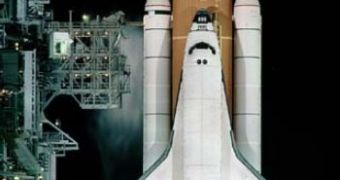You're probably wondering what does a horse's arse have to do with the most modern spacecraft. Well...everything.
First, a simple truth. Most of you know the popular saying "If it ain't broke, don't fix it." This is probably the key to this apparently impossible link.
1. The railroad
For starters, did you know that the US standard railroad gauge (the distance between the inner sides of the two parallel rails that make up a railway track) is 4 feet, 8.5 inches (1435 mm)? This distance is also known as the standard or international gauge.
And what does this have to do with anything, you'll ask. Stick with me and you'll find out.
The standard gauge of 4 ft 85in (1435 mm) was chosen for the first main-line railway, the Liverpool and Manchester Railway (L&MR), by the British engineer George Stephenson, because it was the de facto standard for the colliery railways where Stephenson had worked. Whatever the origin of the gauge, it seemed to be a satisfactory choice: not too narrow and not too wide.
2. The tramways
Railway trains were just an extension of a previous invention, the tramway. It's railway on which trams (streetcars, trolleys) run. It is typically built at street level sharing roads with traffic but may include private right-of-way especially in newer light rail system. Many old tram systems lack platforms, which enables virtually complete integration with other forms of transport and pedestrians making simultaneous use of the streets.
So, since the people who were building tramways were the same to build the train tracks, it was a logical choice for them to use the same tramway gauge for trains.
3. The wagons
If you didn't spot the connection yet, I'll tell you that the people who built the tramways used the same jigs and tools that they used for building wagons, which used the exact same wheel spacing.
And the explanation for their choice of gauge is also scientific. If they tried to use any other spacing, the wagon wheels would break on some of the old, long distance roads in England, because that's the spacing of the wheel ruts. A rut is a depression or groove worn into a road or path by the travel of wheels or skis or by erosion from flowing water.
4. The roads
Did you know that the word "street," whose origin is the Latin "strata", means a paved pathway? If you didn't, let me tell you that the Roman Empire built the first long distance roads in Europe (and England) for their legions. The roads have been used ever since, so the ruts formed on the roads are basically in the same position as they were in the time of Imperial Rome.
5. The horse
Who started forming ruts in the Roman roads? You guessed it, the Roman war chariots. This is where the "if it ain't broke, don't fix it" saying comes into play: everyone else had to match the existing ruts to their wagons and carriages for fear of destroying their wheels. Since the chariots were made for imperial Rome, they were all alike in the matter of wheel spacing, because Romans were the first to introduce systematization (standardizing) in, well, almost every domain, especially engineering.
The Imperial Roman war chariots were made just wide enough to accommodate the back ends of two war horses, since two were more effective than one or four, for steering and combat agility.
So, the United States standard railroad gauge of 4'-8.5" is derived from the original specifications for an Imperial Rome war chariot. All hale bureaucracy!
And now, for the grand finale!
6. The spaceships
The US Space Shuttles rely on auxiliary boosters to provide them with the energy it takes to beat Earth's gravity. You've surely seen that there are two big booster rockets attached to the sides of the main fuel tank. These are solid rocket boosters, or SRBs.
The SRBs provide 83% of liftoff thrust for the Space Shuttle. They are the largest and most powerful solid rockets ever flown, and the most powerful rocket motor of any type (solid or liquid) ever flown.
Of course, NASA isn't going to let just anyone build their most important part of the space shuttle, so the contract for making SRBs was given to an American engineering company, Thikol at their factory in Utah.
The engineers who designed SRBs wanted to make them a bit wider to carry a bigger fuel payload, but the SRBs had to be shipped by train from the factory to the launch site. And the railroad line from the factory happens to run through a tunnel in the mountains, so they had to fit through that tunnel. The tunnel is slightly wider than the railroad track, and the railroad track, as you now know, is about as wide as two horses' behinds.
And there you have it. The world's most technologically advanced means of transportation, the Space Shuttle, has involuntarily been produced to match the "technical" specifications of a horse's South end.

 14 DAY TRIAL //
14 DAY TRIAL //